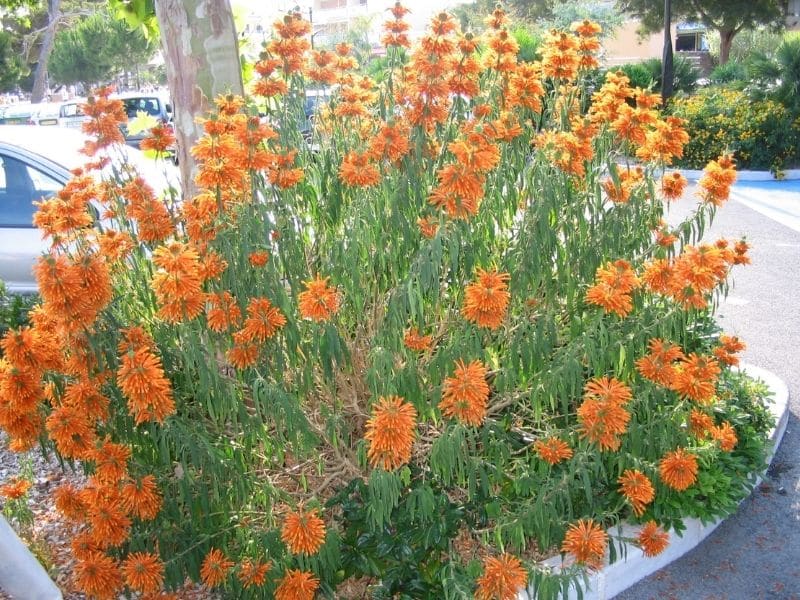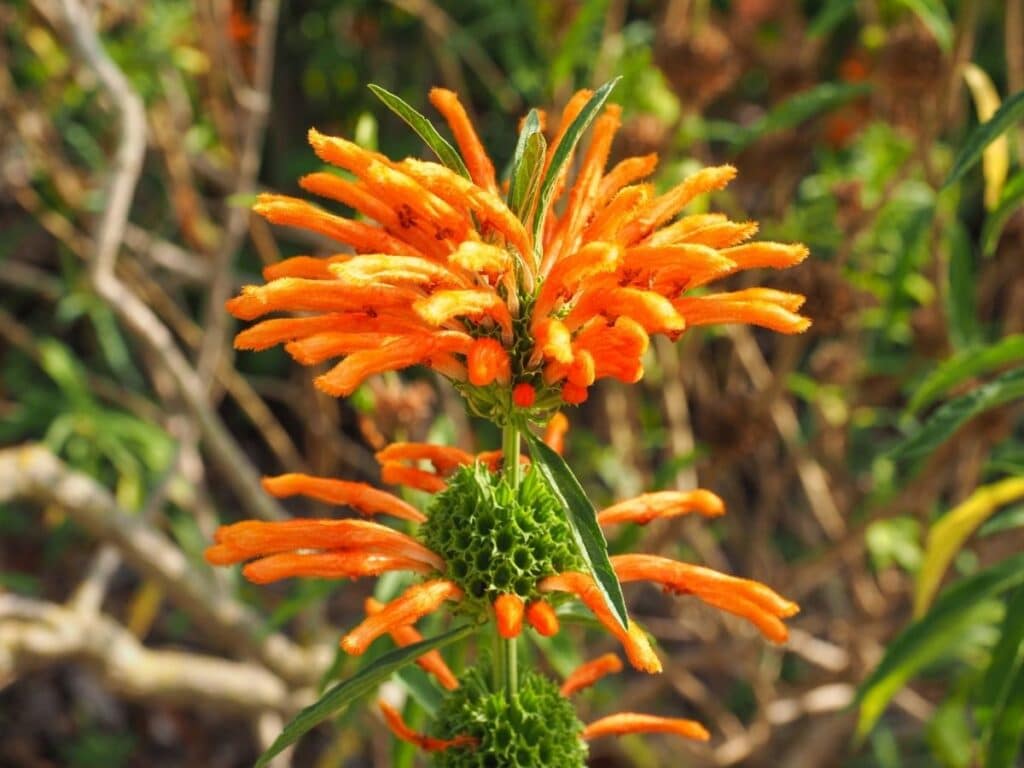If you’re looking for a bold and showy shrub, Leonotis is a good place to start. These distinctive African plants are fast-growing and have interesting, brightly colored blossoms which attract butterflies and hummingbirds.
What Is A Leonotis?
Leonotis leonurus, or lion’s tail, is an evergreen shrub from the mint family (Lamiaceae). The genus name is derived from the Greek words leon meaning “lion” and ous or otis meaning “ear,” in reference to the corolla, which resembles a lion’s ear. These plants are also commonly known as wild dagga. Amusingly, the scientific name for this plant means lion-colored lion ear.
Leonotis is a semi-evergreen shrub, depending on the climate where you grow it. These plants grow to about 8 feet (2.4 m) tall and equally wide in warmer climates but may be restricted to about 5 feet (1.5 m) in cooler zones.
Lion’s tail plant is native to South Africa, where it grows in a variety of habitats.
Lion’s tail leaves are usually about 5 inches (12.5 cm) long and rough-textured. These oppositely arranged leaves have weakly serrated margins and a distinctive herbal aroma if crushed.
The lower stems of these plants are pale and woody but light and brittle, and upper branchlets are greener and square-shaped in cross-section.

Leonotis Flowers
Leonotis flowers are unusual and striking orange flowers. Each flower is a two-lobed tubular blossom, growing up to 2 inches (5 cm) in length. These fluffy tubular flowers emerge in profusion from a spiky ball-shaped flower head on the upper stems.
Leonotis has a prolonged flowering period from late spring to fall in warmer areas but if grown as an annual in colder areas, expect this plant to flower in the fall after being started indoors in the spring.
The seeds of this plant are held in unusual-looking seed heads which resemble paper wasp nests.
Other Leonotis Species
Leonotis nepetifolia, which is often known as Christmas candlestick, is usually a smaller species that is also occasionally used as an ornamental. This species from tropical Africa has broader leaves and a larger flower head, but with smaller, less showy flowers.
Unfortunately, these plants can be quite invasive and are now common weeds in tropical areas of the world. (1)
How To Grow A Leonotis Plant
In warmer areas, this plant will remain evergreen, whereas frost will cause it to drop its leaves.
In frost-prone areas, it is possible to grow this plant as an annual by starting it from seed indoors and moving it outside after the last frost. While it can freeze to the ground in the winter, it will often resprout from hardened wood the spring, which is why it is generally termed a perennial.
Leonotis is a very fast-growing plant that can reach 6 feet (1.8 m) in a single year if planted from seed. The seeds don’t need any treatment and can be sown in the ground or in pots before replanting when they reach around 6 inches (15 cm) tall.
Leonotis seeds are stick-shaped and can be shaken loose from the dried seed heads. (2) Grow these seeds in a fine and light substrate with plenty of organic material worked into it. If cultivated as an annual, the seed should be planted indoors in winter or sown outside before the last frost date for fall flowering.
Lion’s tail plants can also be grown readily from green stem cuttings of 5 inches (12.5 cm) or so. Remove the lower leaves from your cuttings and plant them in a mix of sand and peat moss, and they should develop roots within a month or two.
These plants can be grown in a variety of fast-draining soils but will do best in rich, loamy, and well drained soils. They are quite drought tolerant, but the gardener is advised to keep this plant well watered in the summer months for good growth.
Growing this plant in full sun will promote the most flowers, but these shrubs will also survive in light shade in USDA zones 8 to 11.
Care and Maintenance
Leonotis is a versatile plant that can be grown as semi-evergreen, perennial, or annual. These are low-maintenance shrubs when grown within their preferred climate ranges but will require a good amount of extra care if grown in colder places.
Generally, these plants should be pruned annually, after flowering, to promote a denser growth form. If grown outdoors in areas with frost, prune it down to about 4 to 8 inches (10 to 20 cm) and protect the crown from frost damage with a layer of mulch. The plant should grow back strongly in the next spring.
Fertilizing is not strictly necessary with these plants, but they do enjoy fairly rich soil. If yours is very poor, consider using organic fertilizer in the spring and applying a 4 to 6 inches (10 to 15 cm) deep layer of organic mulch around the square stems to encourage fast growth. (2)
These hardy plants are usually quite a pest- and disease-resistant.
Uses of Lion’s Tail

Horticultural Uses
Leonotis could be used as a background plant for other shrubs or even as a screen, but it can be a little too bold for these applications. Leonotis works great as an accent or specimen plant and can be even be grown in a large container.
This is a great choice for wildlife gardens because of all the pollinators it attracts.
Human Uses
The leaves and stems of this plant are mostly used. Traditional uses include smoking the leaves as a tobacco substitute with a mild narcotic effect or used to make a tea.
Lion’s tail is also used in traditional medicine for the treatment of a wide variety of conditions, including snakebites, cramps, colds, headaches, and skin conditions like eczema. (3)
Wildlife Uses
These plants attract birds (hummingbirds and sunbirds), bees, butterflies, and other pollinators because of its sweet nectar. Fortunately, Leonotis is also highly deer resistant.
FAQs
How do you prune leonotis leonurus?
In the winter, Leonotis can be pruned right back to about 6 inches (15 cm) in frost-prone areas. Just take care to cover the crown in mulch to protect the roots from cold damage. In warmer areas, prune the flowering stems after they have finished flowering to create a denser, neater-looking shrub.
How do you grow leonotis leonurus?
Lion’s tail can be grown from seed, stem cuttings, or from divided plants. These plants can be grown in beds or containers, and it is possible to overwinter plants indoors in very cold climates.
Is Leonotis poisonous?
Leonotis is not considered highly toxic unless taken in dangerously high doses. This plant is not considered edible. Always consult a medical professional before using plants medicinally or for other purposes.
Is Leonotis perennial?
Leonotis is a semi-evergreen but can behave as a perennial in cold climates where plants will die back in the winter before regrowing in the spring. You will have to manually remove old woody growth, however.
Conclusion
Leonotis is a striking and fast-growing shrub. The bold and bright colors of this plant can be shocking in mass plantings so use this shrub as an accent or specimen plant, especially if you wish to attract pollinators to the garden.
Also check more types of orange flowers you can grow.
References
Reference List:
(1) Weeds of Australia Factsheet: Leonotis nepetifolia. Retrieved at https://keyserver.lucidcentral.org/weeds/data/media/Html/leonotis_nepetifolia.htm
(2) Turner, S. Plantzafrica. Leonotis Leonurus. South African National Biodiversity Institute. Retrieved at http://pza.sanbi.org/leonotis-leonurus
(3) van Wyk, B., van Oudtshoorn, B. & Gericke, N. Medicinal Plants Of South Africa
Close
*image by LifeCollectionPhotography/depositphotos







